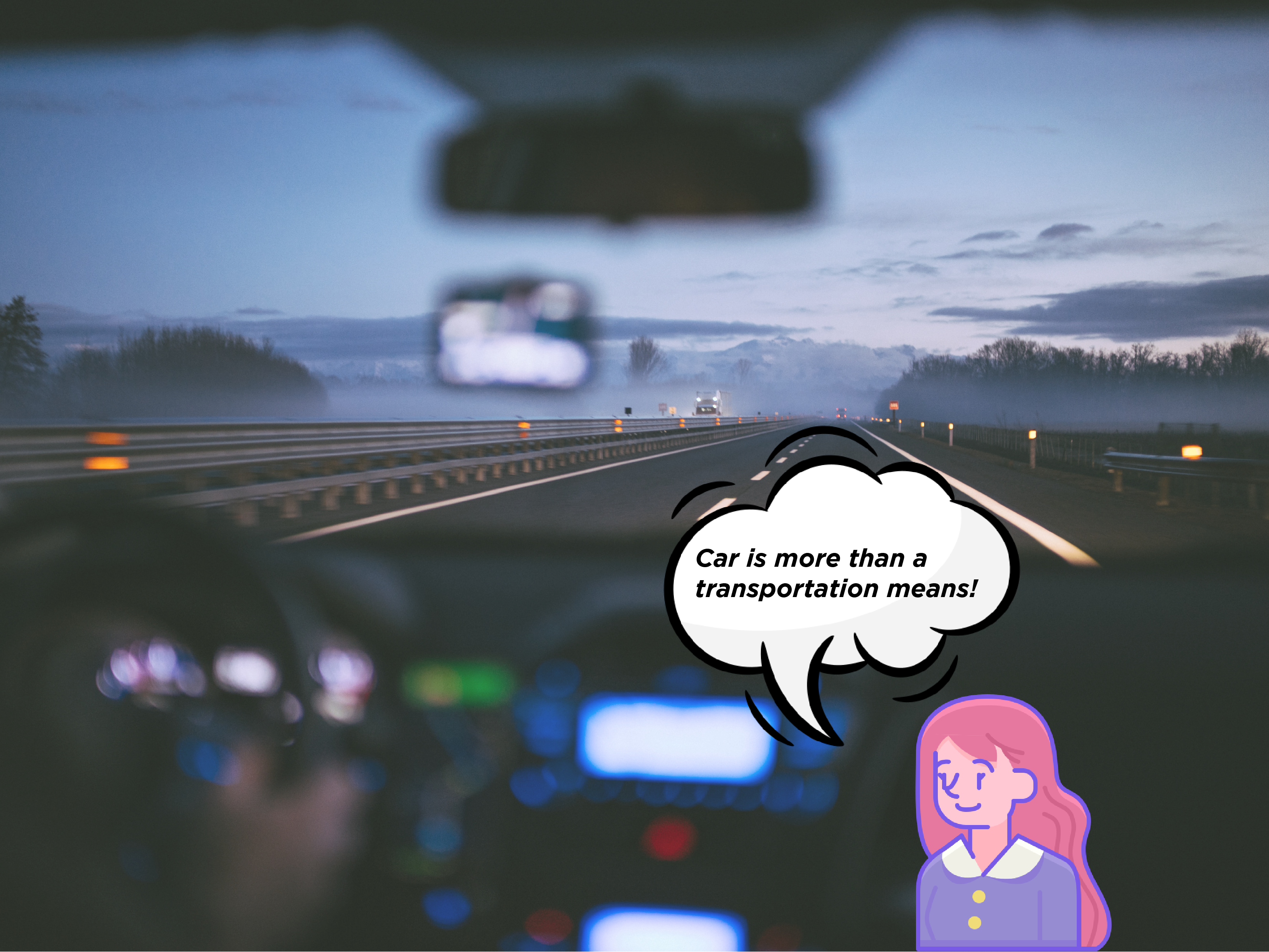
Exhibition 1_Page Group 02
| Team number | ?Group 02 |
|---|---|
| Students | JeonghaZeynepLisa LShicheng Huo |
| Coach | Tomasz Jaskiewicz |
| Brief | Ford |
| Keywords | EmotionRelationshipconnectiontrust |
| Exhibition link | https://itd2021.notion.site/Exhibition-1_Page-Group-02-d710c1b489544f0199c73ee780d89c60 |
| Status | Finished |
| One liner! | Meaningful time by connecting with your private mobile space and building trust |
| Link to video |
AI and personal mobility: building trust through connecting with your private mobile space
Proposition: HMW create trustworthy AI based experiences that are relevant to our passenger vehicle users and our commercial vehicle users?
In the future, we imagine that trustworthy AI can help private drivers experience their car as a personal space to spend meaningful time in, as opposed to a vehicle that transports them.
Introduction
We all want to make our time more valuable, since time is irreversible. People, who have a personal vehicle, actually spend a considerable amount of time in the car while going to work, school or traveling to different place. This entire time spent in the car can be considered to be "wasted" since you are actually not making anything productive.
How about thinking that personal cars are not just means of transportation from point A to B, but also another destination in itself where you can spend more valuable time with the help of AI?

We want to explore how the emotional connection within this personal space can change with AI, defining a car as a personal space, following three different dimensions:
1.personal connection with a car itself
2.Connection with the place you are in
3.Connection with other drivers on the road
Therefore, we expect that AI would help drivers to appreciate their time in driving, to be more comfortable using it, and thus, to trust the AI further.
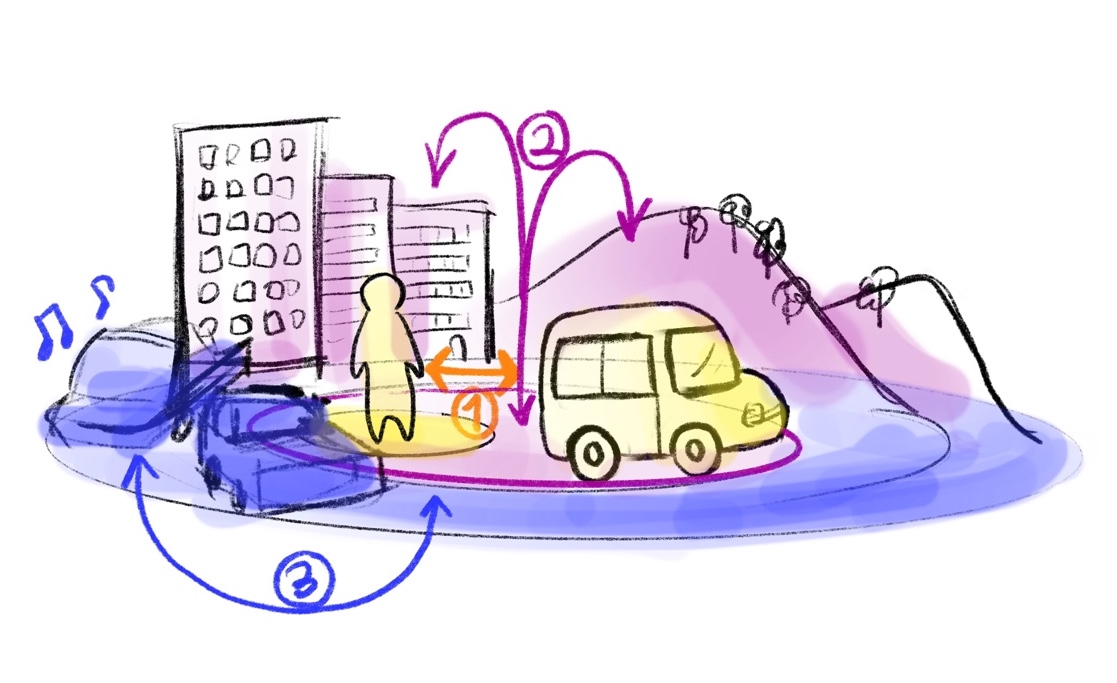
CONCEPT 1.Personal connection with a car itself
CONCEPT 1.Personal connection with a car itself
as an emotion-care friend
Drivers feel different kinds of emotions through their journey due to various urban, personal or environmental factors. Dealing with emotions related to urban driving is important to have a safe drive. The emotion-care system as data transfers to the car, and the car will give correspondent responses, such as music recommendations and ambient light changing properly to the users based on users? emotion expression.

???Scenario
User: a private driver who experiences different emotions throughout his ride
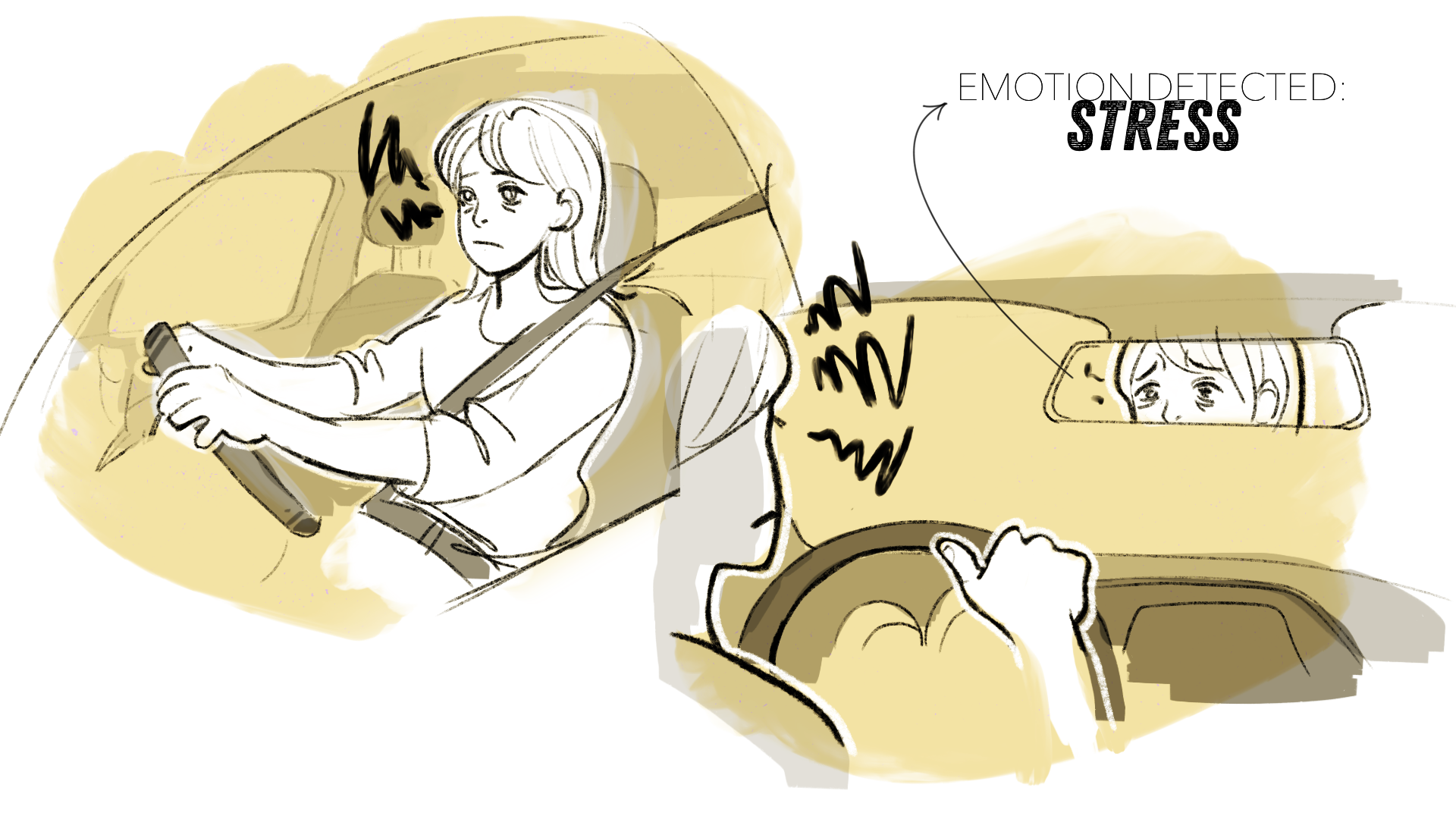
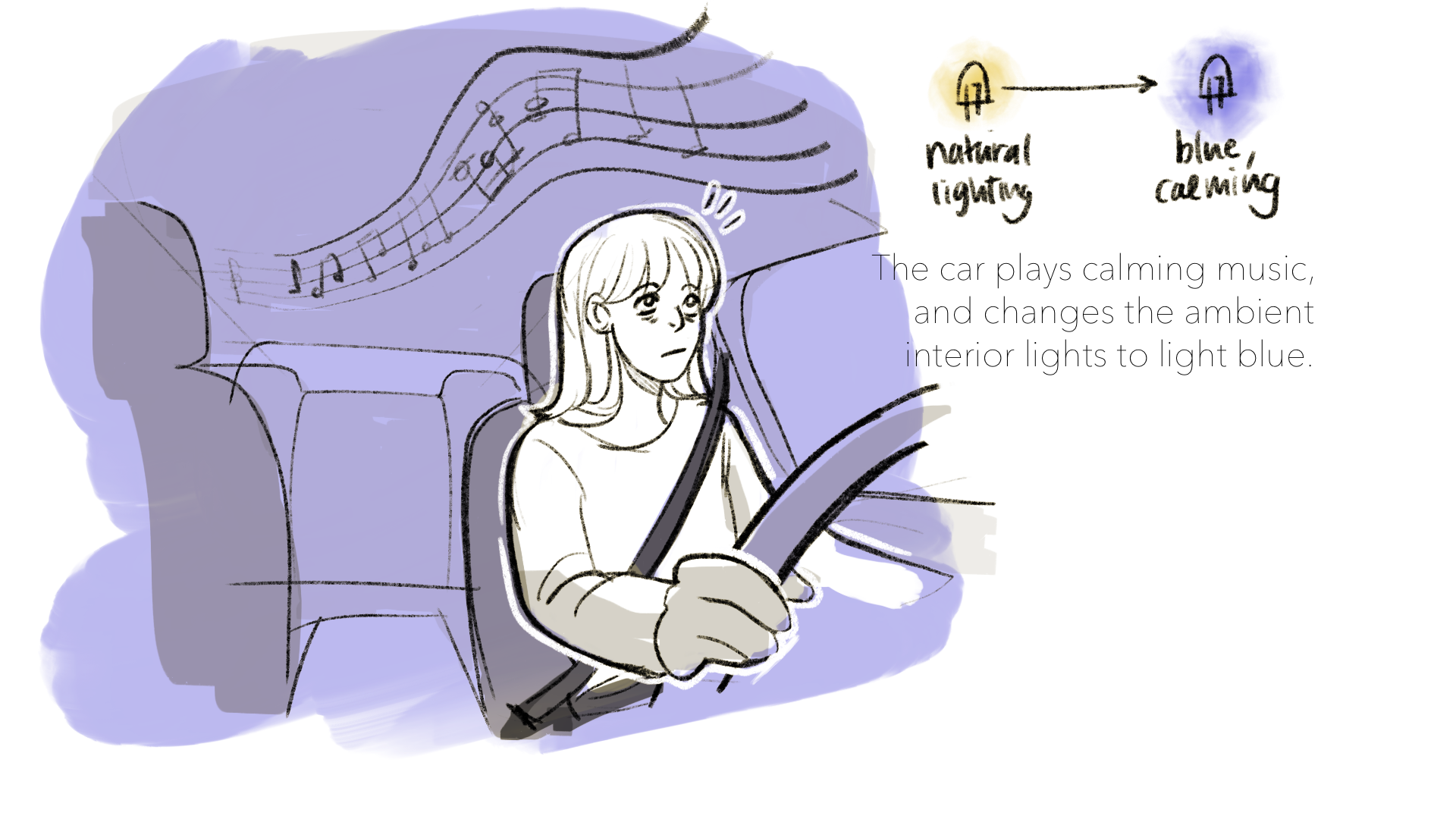

Why is it meaningful?
Cars function well as machines. But we hope that when the car, AI and the user are in the same scenario, an emotional connection can be established. This connection represents warm and in-depth communication. In this concept, car has other identity on sharing cares and smooth the emotions to users with instant feedback.
??Exploration by prototyping tests
Findings:
- Facial expressions are very personal and complex to conclude pattern.
- The barriers between being watched should be considered.
CONCEPT 2.Connection with the place you are in
CONCEPT 2.Connection with the place you are in
As an Interactive journey experience
When users face the time with stress or chaos in the lifetime, they can step into the car to have a personal space while releasing their stress. However, they might have no idea about what to do and where to go to make their feeling better. The AI can suggest unexpected journey plan for the driver to spend meaningful and appreciative time with the car.
???Scenario
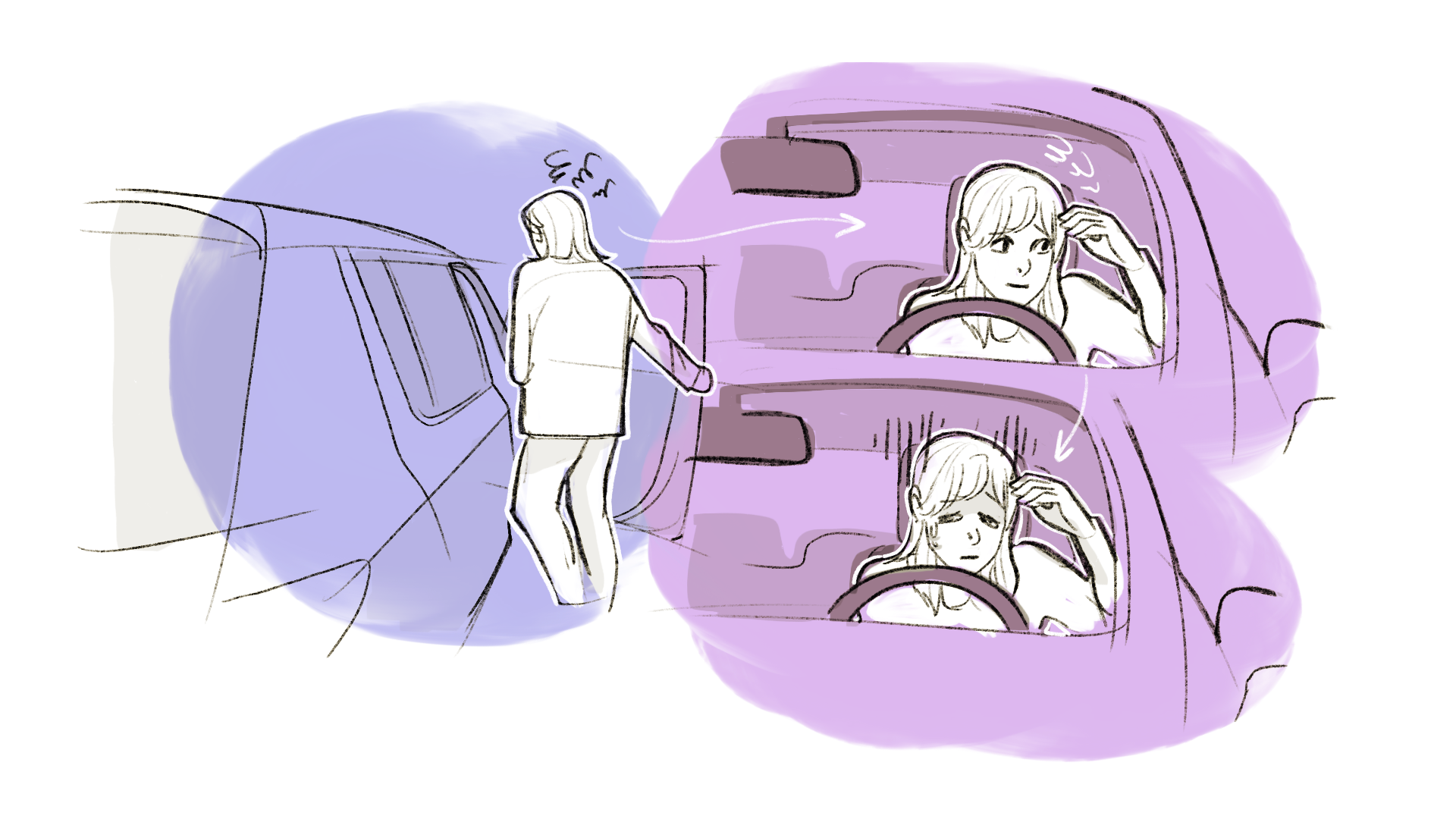
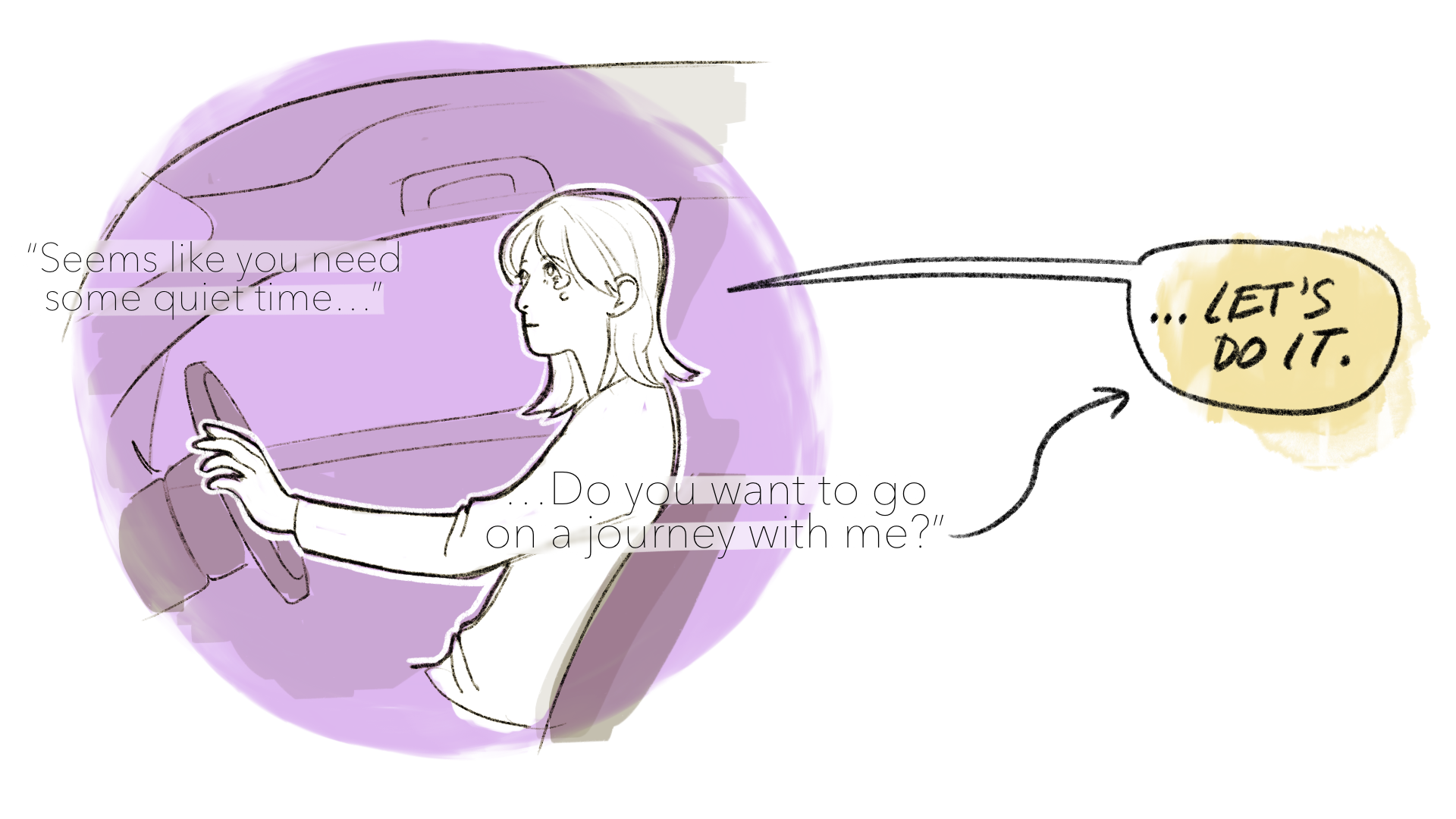
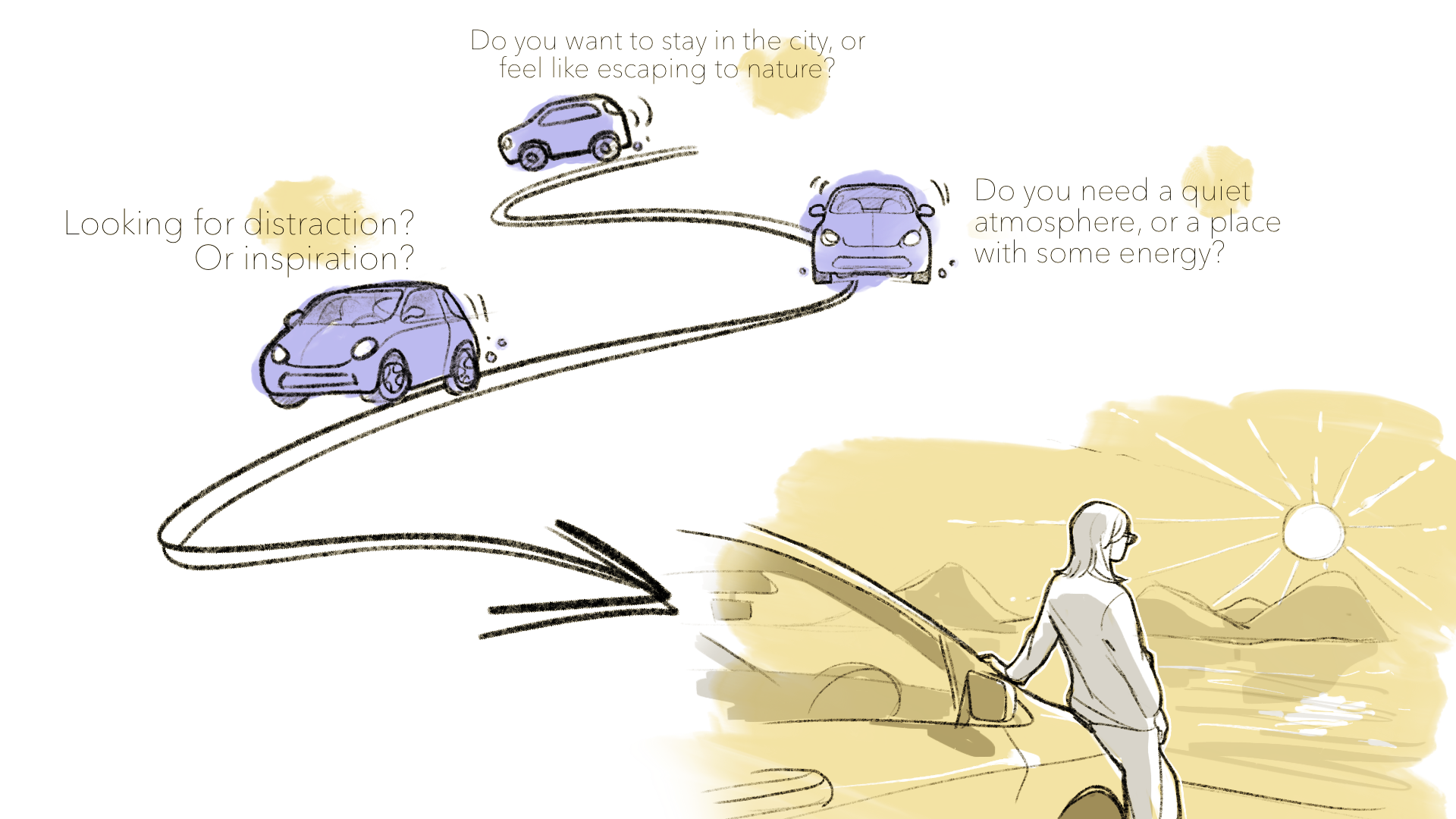
User: a private driver who need to deal with the stress
Why is it meaningful?
As a new destination that drivers enjoy their time, a car with AI will help drivers to release their stress and to enjoy an unexpected journey as a buddy for travel. Users will have an intuitive and interactive journey without being frustrated on planning.
We created an interaction that is more of a consensual exchange in order to make AI more trustworthy. Biodata being constantly measured and interpreted might make drivers feel an invasion of privacy. Therefore, the questions are vague but suggestive enough to make the user feel like they are opening up about their feelings. At the same time, they are being guided by their car to a destination that will better their current mood.
The users will willingly share this information, as the anticipation of the unknown destination will make them want to co-operate. At the same time, they feel like the car is supporting them in finding a spot to make them feel better.
??Exploration by prototyping tests
Findings:
- AI suggestions helped to make a driver in less willingness feel better from quick tests.
- Using a chat (typing) seems to work better than using a voice, because some pronunciations are not accurate and makes some errors
- The utterances should embody all possible answers, including misspellings and mispronunciations of the words.
Insights:
- Low yet calm voice of women (Amazon-Alexa voice) would give thrust feeling to drivers from quick tests.
- The more diverse utterances we input, the smarter AI responds.
- More things to explore:
- Will the voice interactions are needed in the entire journey?
- What will be other elements stimulated in the car?
CONCEPT 3.Connection with other drivers on the road
CONCEPT 3.Connection with other drivers on the road
by sharing the beats on the roads
The cars are mechanical, and, in the traffic, drivers are likely to forget about the people in other cars. The AI can help people to connect with other drivers on the road through sharing their music beats on the exterior of their cars. AI in each car would enable the drivers to listen the same tracks as the beats that they see on the back of other cars. Through this way, the drivers will both be entertained and also feel connected to the other cars in the traffic who share the same fate.
???Scenario
User:
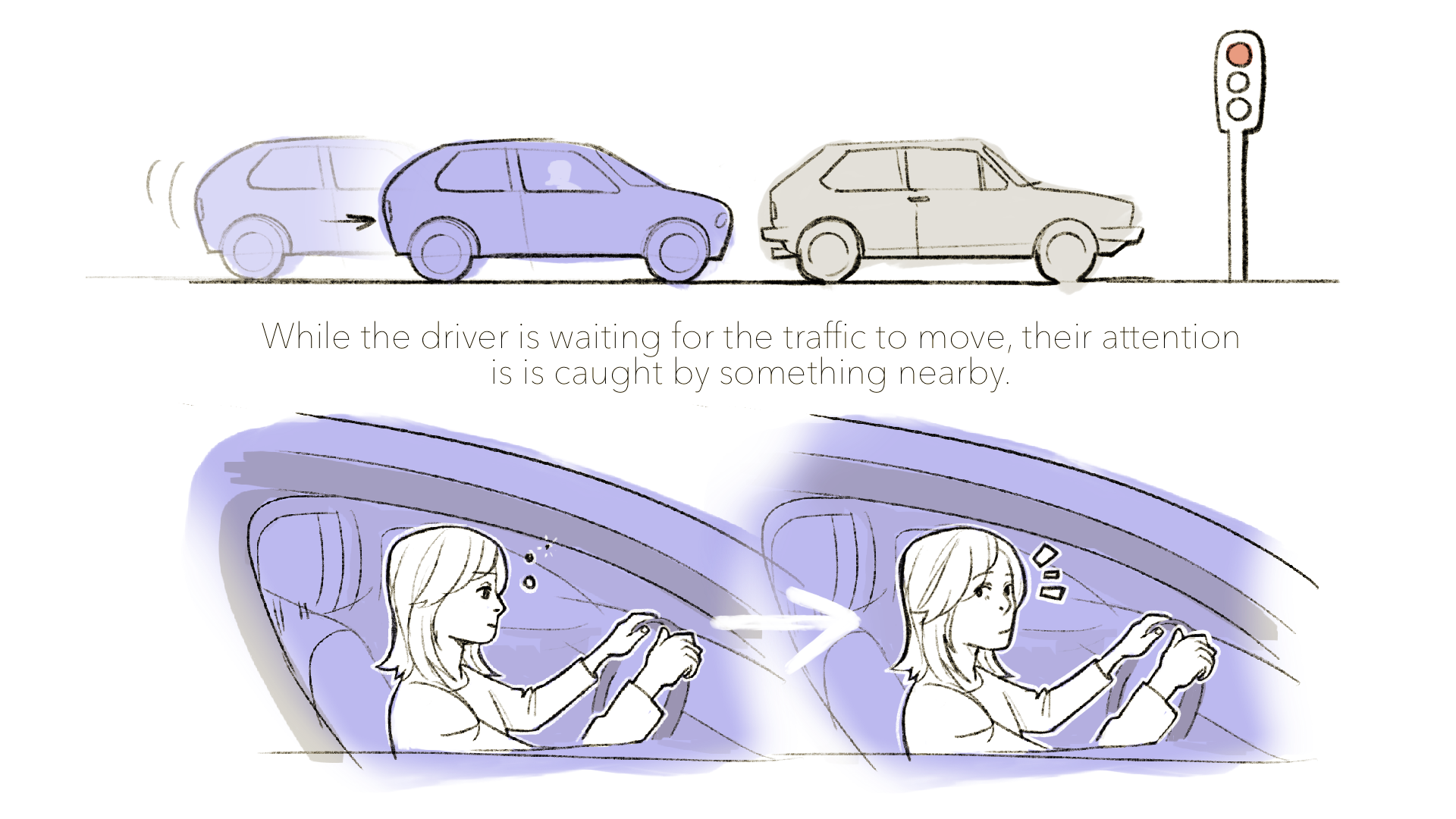
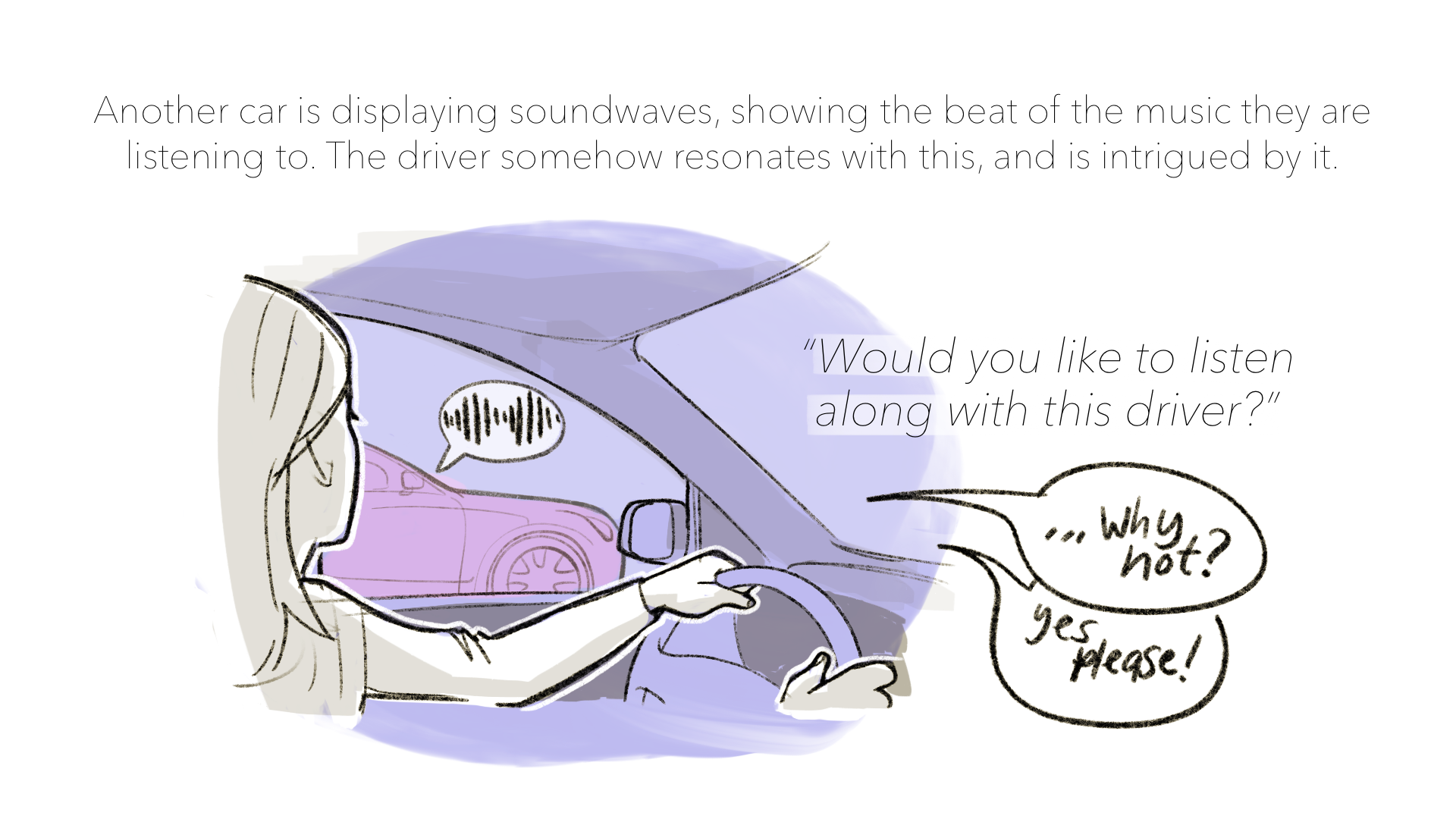
Why is it meaningful?
Currently, we face many instances where we lose our temper, or are confused with other drivers since we lose sight of them, as they are hidden inside a steel box. In the future, we feel that this phenomenon will increase, as AI will ?improve? driver?s behavior. Although this makes the roads safer and efficient, the driving behavior, and by extension our perspectives of each other on the road, will be less human.
At the same time, we feel that the car is a personal space to spend private time in, and we don?t want to feel exposed to strangers.
Listening to music is one of the most common ways to spend time in the car. Since it is audial, it does not keep the drivers? eyes off the road. In addition, you can maintain your personal boundaries while showing personal preferences.
Sharing the beats on the roads would be a way to shift the drivers attention from the steel vehicles around to actually the humans inside. The interaction with the other drivers on the road will make them feel connected to each other. This way, they may escape from the chaotic atmosphere of the traffic and have a surprising and fun ride. It is also a way to increase the music knowledge of drivers and introduce new songs to them which they may like.
??Exploration by prototyping tests
Findings:
- There could be moments when the driver wants to be left alone and not interact with any others or the AI
- Seeing moving patterns and colors at the back of cars could be irritating and distracting after some point especially if you are not in the mood of interacting with other cars
Insights:
- The interaction should be two-way in order to form a real connection with the drivers around.
- The driver should be able to turn on/off the AI (speaking to them) and the colors at the back of the cars, depending if they want to interact with the other cars or if they want to listen to their own music or maybe no music at all.
More info and findings
| Name | Created | Tags |
|---|---|---|
| Concept 1 - Personal connection with an individual car | ||
| Concept 2 - Connection with the place you are in | ||
| Concept 3 - Connection with other drivers on the road |
Takeaways?
??In the technology aspect:
Choose the technology wisely regarding the purpose
There are lots of tools we can use for making prototype. It is interesting to explore all the technologies with prototypes. We learn and practice through technologies. After exploration, we learnt and practice. However, to use the combination of technology wisely can booster on our prototypes. For example, using the FaceMesh instead of ML5 can increase the accuracy on recognizing the facial expression.
Explore more various AI tools for more interactive prototypes
During our concept, there are lots of touch points we would like to have technology involve. How to combine tools to empower prototype with different interactions are one of our challenges. To overcome the challenge, we try, practice and learn among different tools such as Voice Flow, Impulse, Arduino and P5.js. Since we are thinking the idea in a bigger picture with different interaction inputs. In the future, we would like to try more sensor like vibration sensors.
? In the interaction design aspect:
Thinking in the speculative way
helps us to have more intriguing and intuitive ideas.
Humanizing AI to increase trustworthiness
Interactions are various in the car. When thinking of the car in 2035, we are not limited ourselves to the current car capabilities but seek for more possible opportunities on interactions. We have discussed about the interior environment, AI voice systems and auto recognization with instant feedback. Most importantly, we focus to create humanize interactions such as instant feedback after recognizing facial expressions, interactive journey assistant that provide mindfulness to users and music sharing with visualization beats to connect drivers.
Change the perspective toward vehicles beyond users
We don?t only focus on individual user, but from user we think of context and related actors in the eco system. For each concept brainstorming, we think car beyond a machine and tools. Car is a space, a destination, a company, a friend and an expert. Through these concepts we try to explore cars identities in the near future and its related technology usages.
Next Step?
Defining the scope we want to focus on
We have explore and discuss many possibilities. From the concepts we had right now, we have ideas around relationship building, community connections and emotion care. In the future, we are planning to focus on to merge the parts that are validated through test and interesting interactions possibilities.
 https://creator.voiceflow.com/prototype/6218a23612551b7c4d54be88
https://creator.voiceflow.com/prototype/6218a23612551b7c4d54be88